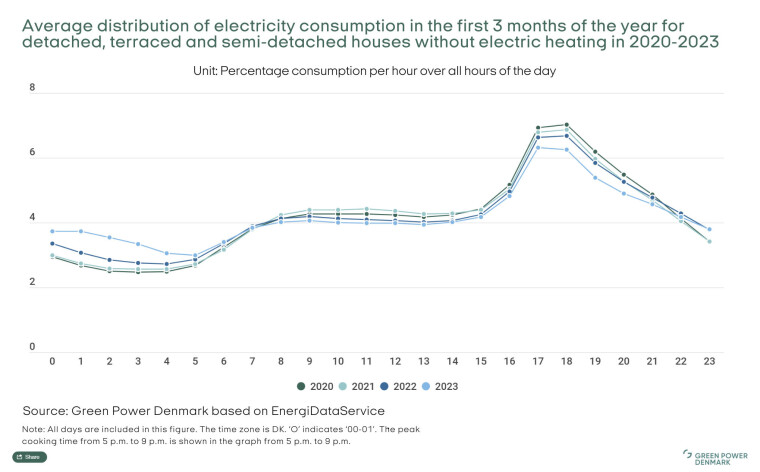Researchers' Zone:

You can save CO₂ by changing when you take a shower
My research project shows how dynamic heating prices can help us move away from fossil fuels
You wake up on a cold winter morning, turn on the shower, and crank up the radiator.
Right then, energy consumption spikes in thousands of homes – and behind the scenes, the fossil boilers fire up.
But what if the price of heating followed the availability of green energy, and you could actually save both money and CO₂ by timing your shower (and heat usage in general) a bit more wisely?
I am doing my PhD on district heating at DTU, and below I’ll explain why a so-called 'dynamic heat pricing' model could help drive the green transition.
We Need Heat at the Same Times
Our heating habits (like many other habits) are remarkably synchronized: We turn on the radiators, shower, and use hot water at the same times, especially in the morning and evening.
This creates intense consumption peaks, where the demand for heat exceeds what green energy sources like waste incineration and surplus heat can deliver.
That’s when fossil backup sources kick in, such as oil and gas boilers, and this happens every day.
Most hours of the day, there’s actually plenty of green heat available. Today, over half of the energy used for district heating comes from green sources like waste incineration, combined heat and power plants, and large heat pumps.
The problem arises when consumption happens simultaneously in thousands of homes, offices, and schools. In those moments, district heating companies must draw extra energy from fossil sources to meet the short-term peak demand.
What Is Dynamic Pricing – and Why Does It Work?
One solution to avoid fossil sources is to develop more and larger green energy sources, such as waste heat recovery from data centers, solar thermal systems, renewable energy-powered heat pumps, etc.
But there’s also a cheaper solution: so-called 'dynamic pricing.' Dynamic pricing means that the price of heat changes hour by hour, reflecting how much green heat is available compared to how much is needed at each hour.
A high price during peak hours means that there are fewer green sources available than required. This would encourage consumers to change their heat consumption, for example by lowering radiator thermostats or planning their shower for later.
These small adjustments would help to remove the need for fossil fuels and help consumers save on their heating bills at the same time!
We already do it
Until now no one have examined how ‘easy’ the changes would be, if people are interested in changing the time of day they take a shower for example. But the solution isn’t exactly new – we already know it from our electricity bills.
Most of us use dynamic pricing in Denmark to plan our electricity use. More than 70 percent of households in Denmark actively monitor electricity prices daily to plan their loads.
Roughly, a 10 – 30 percent reduction in bills can be achieved by shifting electricity loads from expensive to cheap hours.
Statistics show that dynamic pricing caused the electricity peak load to fall by 10 percent from 2020 to 2023, mainly by shifting loads like charging EVs, laundry and dishwashers from the evenings to midnight.
In fact, the shift has been so large that midnight is not the cheapest time of the day anymore!

Why don’t we have it yet?
One big reason why dynamic pricing hasn’t been used in district heating yet is that we simply don’t know enough about it, as the lack of studies on the willingness to change habits in relation to heat consumption also reflects.
While there have been many studies on electricity prices, heating has been mostly overlooked.
We need more studies and pilot tests to understand what the price profile should look like, how people responds to dynamic prices in relation to their willingness to change habits, and what the potential challenges are.
My PhD focuses exactly on how we should determine the prices and how people will react, and I study this by doing simulations and experiments.
In a recent study, we used computer simulations to test dynamic heating prices in a neighborhood in Sønderborg, Denmark.
Heat bills nearly cut in half in virtual test
We developed a method to set smart, dynamic prices that encourage people to move their heat use to better times to avoid fossil fuels. Then we tested it with a virtual model of a neighborhood.
The results showed that if people could follow the dynamic prices, the peak heat use could be cut up to 84,4 percent, and their heating bills would be reduced by 46,6 percent compared to a fixed price.
This shows that dynamic price can benefit both district heating companies and consumers.
Until now, no real-world experiments have tested dynamic pricing in district heating, but we hope to start small pilot projects soon.
The savings need to be clear and big enough
Still, for dynamic pricing to really work, people need to be involved. If no one knows about the benefits, no one will change their habits.
That’s why the savings—both for the wallet and the environment—need to be clear and big enough to motivate action.
With climate change and rising energy problems, every small cut in carbon emissions makes a difference.
We’ve already seen how dynamic prices can help reduce peak loads in electricity. The same idea could be used for district heating to cut down on fossil fuels. But how well it works depends on how we respond to price changes.
Of course, sometimes you can’t delay a shower or need a warmer room when you’re sick—or maybe you just don’t feel like adjusting. And that’s okay. What really matters is how we act together, as a whole.









